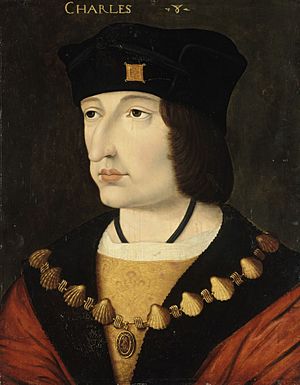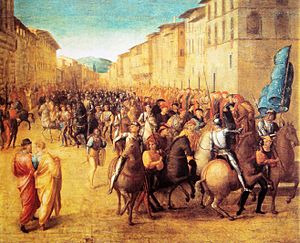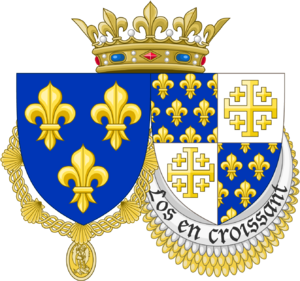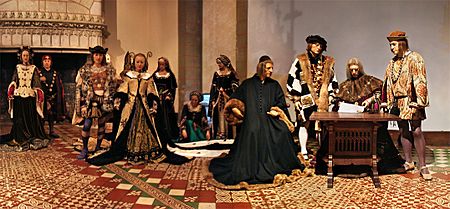Charles VIII of France facts for kids
Quick facts for kids Charles VIII |
|
|---|---|

16th-century portrait after Jean Perréal
|
|
| King of France (more...) | |
| Reign | 30 August 1483 – 7 April 1498 |
| Coronation | 30 May 1484 (Reims) |
| Predecessor | Louis XI |
| Successor | Louis XII |
| Regent | Anne of France and Peter II, Duke of Bourbon (1483–1491) |
| Born | 30 June 1470 Château d'Amboise, France |
| Died | 7 April 1498 (aged 27) Château d'Amboise, France |
| Burial | 1 May 1498 Saint Denis Basilica (body) Notre-Dame de Cléry Basilica, Cléry-Saint-André (heart) |
| Spouse | |
| Issue among others... |
Charles Orlando, Dauphin of France |
| House | Valois |
| Father | Louis XI of France |
| Mother | Charlotte of Savoy |
| Signature |  |
Charles VIII, also known as Charles the Affable, was the King of France from 1483 until his death in 1498. He became king when he was just 13 years old, after his father, King Louis XI, passed away.
Because Charles was so young, his older sister, Anne, and her husband, Peter II, Duke of Bourbon, ruled France for him. They were called his regents. This lasted until 1491, when Charles turned 21. During this time, some powerful lords tried to rebel against the king's power in a conflict called the Mad War. But the royal government won, keeping control.
In 1491, Charles made a bold move. He married Anne of Brittany, even though she had already been promised to Maximilian I, a powerful ruler from the Habsburg family. This marriage was important because it brought the region of Brittany under French control. This helped France avoid being surrounded by Habsburg lands.
Charles also wanted to claim the throne of Naples in Italy. To do this, he made agreements with other rulers to keep them from interfering. He then led his army into Italy, conquering much of the Italian peninsula easily. However, other Italian states and powerful countries formed a group called the League of Venice to stop him. They fought Charles's army at the Battle of Fornovo. Charles managed to lead his army back to France, but he lost his control over Naples.
Charles died in 1498 after accidentally hitting his head on a doorframe at the Château d'Amboise. He had no sons who lived to inherit the throne. So, his cousin and brother-in-law, Louis XII, became the next King of France.
Contents
Becoming King
Charles was born at the Château d'Amboise in France. He was the only son of King Louis XI and his wife, Charlotte of Savoy, who lived to adulthood. His godparents included important people like Charles II, Duke of Bourbon.
Charles became king on August 30, 1483, when he was 13. He was not very healthy. People at the time thought he was kind but also a bit foolish. They felt he wasn't really suited to run the country.
His father, King Louis XI, had wanted Charles's older sister, Anne, to be in charge. Anne was very smart and clever. Her father even called her "the least foolish woman in France." She ruled as regent with her husband, Peter of Bourbon, until 1491.
His Marriage
When Charles was young, he was promised in marriage to Margaret of Austria. She was only three years old at the time. This promise was part of a peace agreement between France and the Duchy of Burgundy in 1482. Margaret brought some lands, like Artois and Burgundy, to France as her dowry. She grew up in the French court, expecting to become queen.
However, in 1488, the Duke of Brittany died. His daughter, Anne, became the heir. Anne wanted to keep her duchy independent from France. So, in 1490, she arranged to marry Maximilian, who was Margaret's father.
Charles's sister, Anne, and her husband didn't like this plan. They didn't want the powerful Habsburg family to control lands on two sides of France. So, the French army invaded Brittany. Anne of Brittany was forced to cancel her marriage to Maximilian. Instead, she agreed to marry Charles VIII.
In December 1491, Charles and Anne of Brittany were married in a grand ceremony. Anne was 14 and not happy about this arranged marriage. But Charles's marriage gave him more freedom from his relatives. He started making his own decisions about how to rule.
What about Margaret of Austria, Charles's first fiancée? She was eventually sent back to her family in 1493. She got her dowry lands back, but France kept the Duchy of Burgundy.
War in Italy
To make France safe from attacks, Charles made peace agreements with other countries. He signed treaties with Maximilian I of Austria and King Henry VII of England. He gave them some things to make sure they would stay neutral. For example, he stopped supporting someone who claimed to be the English king. Charles then used France's money to build a large army. This army included some of Europe's first siege trains, which were big cannons used to attack castles.
In 1489, Pope Innocent VIII offered Charles the throne of Naples. Charles had a distant claim to Naples through his grandmother. Later, another Pope, Pope Alexander VI, also got involved in Italian politics. In 1493, the Duke of Milan, Ludovico Sforza, asked Charles for help. Milan was worried about Naples. Charles gave back some land to Spain to free up his army for Italy. In 1494, the King of Naples died, and his son, Alfonso II, became king. Alfonso II also wanted to control Milan. So, Charles decided to invade Italy and claim Naples for himself.

In September 1494, Charles invaded Italy with 25,000 soldiers. This included 8,000 Swiss mercenaries. His army marched through Italy with very little resistance. They reached Naples in February 1495 and took the city without a big battle. Charles was crowned King of Naples.
Some people in the city of Florence welcomed Charles. A famous friar named Girolamo Savonarola believed Charles was sent by God to make Florence a better, more moral city. He thought Charles would help fix the Church. This caused problems between Savonarola and Pope Alexander VI, who didn't want Charles interfering in Italy.
The quick success of the French army scared other Italian rulers. Even Ludovico of Milan, who had asked for Charles's help, became worried. So, they formed a group called the League of Venice in March 1495. This League included states like Milan, Venice, and Florence, along with Spain and the Holy Roman Empire. They hoped to trap Charles in southern Italy.
At the Battle of Fornovo in July 1495, the League tried to stop Charles from returning to France. The League lost more soldiers than Charles. Although Charles lost most of the treasures he had taken, the League could not stop him from marching his army back to France. Meanwhile, the Spanish army quickly took back Naples from Charles's remaining soldiers. In the end, Charles VIII lost all the lands he had gained in Italy.
For the next few years, Charles tried to build up his army again. He wanted to go back to Italy, but he had a lot of debt from his first invasion. He never managed to gain anything important in Italy again.
His Death
Charles died in 1498, about two and a half years after his return from Italy. He died because of an accident. He was going to watch a game of jeu de paume (an old form of tennis) at the Château d'Amboise. He accidentally hit his head on the top part of a doorframe, called a lintel. Around 2:00 p.m., he fell into a coma and died nine hours later.

Charles left France with many debts because of his ambitions. However, his trip to Italy did help bring Italian art and ideas to France. This helped the French Renaissance grow.
Since all of Charles's children died before him, he was the last king from the main line of the House of Valois. After his death, the throne went to his cousin and brother-in-law, Louis XII. Anne of Brittany tried to make her duchy independent again. To stop this, Louis XII ended his marriage to Charles's sister, Joan, and married Anne himself.
His Children
Charles and Anne had six children, but sadly, all of them died very young:
- Charles Orland, Dauphin of France (born 1492 – died 1495). He died from measles when he was three years old.
- Francis (born August 1493). He was born too early and did not survive.
- A daughter (born March 1495). She was stillborn.
- Charles, Dauphin of France (born September 1496 – died October 1496). He lived for less than a month.
- Francis, Dauphin of France (born July 1497). He died just a few hours after being born.
- Anne of France (born March 1498). She died on the day she was born.
In Media
Charles VIII's life and reign have been shown in plays and TV shows:
- The 1671 English play Charles VIII of France by John Crowne is about his time as king.
- His invasion of Italy and his relationship with Pope Alexander VI are part of the novel The Sultan's Helmsman.
- In the 2011 TV series The Borgias, Charles VIII is played by French actor Michel Muller.
- In the 2011 French-German show Borgia, Charles VIII is played by Simon Larvaron. This show also includes his death, but with a small change: Charles plays a game of jeu de paume with Cesare Borgia and hits his head when leaving the game.
- In the 2017 German-Austrian show Maximilian, a young Charles is played by French actor Max Baissette de Malglaive.
See also
 In Spanish: Carlos VIII de Francia para niños
In Spanish: Carlos VIII de Francia para niños
- First Italian War
- Louis III of France, another French king who died after hitting his head on a doorframe.
Images for kids
Sources
- Pigaillem, Henri (2008). Anne de Bretagne epouse de Charles VIII et de Louis XII. Pygmalion.
|
Charles VIII of France
Cadet branch of the Capetian dynasty
Born: 30 June 1470 Died: 7 April 1498 |
||
| Regnal titles | ||
|---|---|---|
| Preceded by Louis XI |
King of France 30 August 1483 – 7 April 1498 |
Succeeded by Louis XII |
| Preceded by Ferdinand II |
King of Naples 1495 |
Succeeded by Ferdinand II |
| French royalty | ||
| Vacant
Title last held by
Francis |
Dauphin of France 1470–1483 |
Vacant
Title next held by
Charles Orlando |
| Titles in pretence | ||
| Preceded by Andreas Palaiologos |
— TITULAR — Emperor of Constantinople 1494–1498 |
Succeeded by Andreas Palaiologos or Louis XII (claimed by both) |




